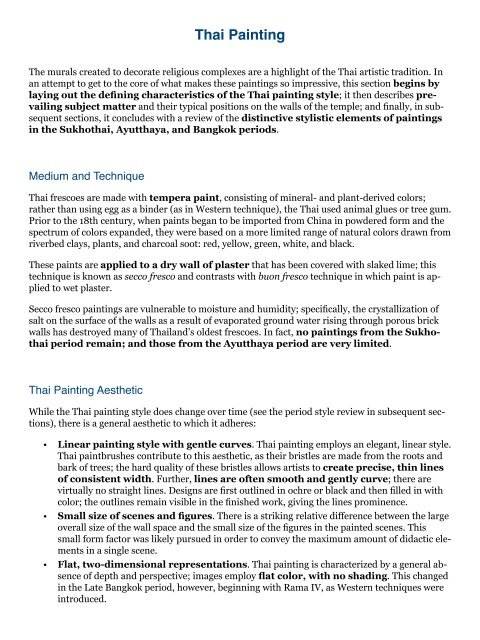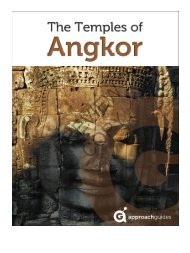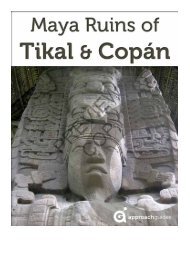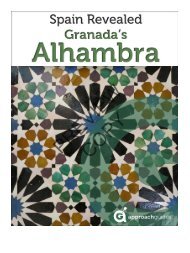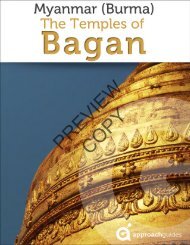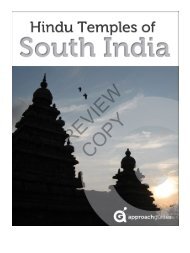The Temples of Bangkok - Approach Guides
The Temples of Bangkok - Approach Guides
The Temples of Bangkok - Approach Guides
You also want an ePaper? Increase the reach of your titles
YUMPU automatically turns print PDFs into web optimized ePapers that Google loves.
Thai Painting<br />
<strong>The</strong> murals created to decorate religious complexes are a highlight <strong>of</strong> the Thai artistic tradition. In<br />
an attempt to get to the core <strong>of</strong> what makes these paintings so impressive, this section begins by<br />
laying out the defining characteristics <strong>of</strong> the Thai painting style; it then describes prevailing<br />
subject matter and their typical positions on the walls <strong>of</strong> the temple; and finally, in subsequent<br />
sections, it concludes with a review <strong>of</strong> the distinctive stylistic elements <strong>of</strong> paintings<br />
in the Sukhothai, Ayutthaya, and <strong>Bangkok</strong> periods.<br />
Medium and Technique<br />
Thai frescoes are made with tempera paint, consisting <strong>of</strong> mineral- and plant-derived colors;<br />
rather than using egg as a binder (as in Western technique), the Thai used animal glues or tree gum.<br />
Prior to the 18th century, when paints began to be imported from China in powdered form and the<br />
spectrum <strong>of</strong> colors expanded, they were based on a more limited range <strong>of</strong> natural colors drawn from<br />
riverbed clays, plants, and charcoal soot: red, yellow, green, white, and black.<br />
<strong>The</strong>se paints are applied to a dry wall <strong>of</strong> plaster that has been covered with slaked lime; this<br />
technique is known as secco fresco and contrasts with buon fresco technique in which paint is applied<br />
to wet plaster.<br />
Secco fresco paintings are vulnerable to moisture and humidity; specifically, the crystallization <strong>of</strong><br />
salt on the surface <strong>of</strong> the walls as a result <strong>of</strong> evaporated ground water rising through porous brick<br />
walls has destroyed many <strong>of</strong> Thailand’s oldest frescoes. In fact, no paintings from the Sukhothai<br />
period remain; and those from the Ayutthaya period are very limited.<br />
Thai Painting Aesthetic<br />
While the Thai painting style does change over time (see the period style review in subsequent sections),<br />
there is a general aesthetic to which it adheres:<br />
• Linear painting style with gentle curves. Thai painting employs an elegant, linear style.<br />
Thai paintbrushes contribute to this aesthetic, as their bristles are made from the roots and<br />
bark <strong>of</strong> trees; the hard quality <strong>of</strong> these bristles allows artists to create precise, thin lines<br />
<strong>of</strong> consistent width. Further, lines are <strong>of</strong>ten smooth and gently curve; there are<br />
virtually no straight lines. Designs are first outlined in ochre or black and then filled in with<br />
color; the outlines remain visible in the finished work, giving the lines prominence.<br />
• Small size <strong>of</strong> scenes and figures. <strong>The</strong>re is a striking relative difference between the large<br />
overall size <strong>of</strong> the wall space and the small size <strong>of</strong> the figures in the painted scenes. This<br />
small form factor was likely pursued in order to convey the maximum amount <strong>of</strong> didactic elements<br />
in a single scene.<br />
• Flat, two-dimensional representations. Thai painting is characterized by a general absence<br />
<strong>of</strong> depth and perspective; images employ flat color, with no shading. This changed<br />
in the Late <strong>Bangkok</strong> period, however, beginning with Rama IV, as Western techniques were<br />
introduced.


